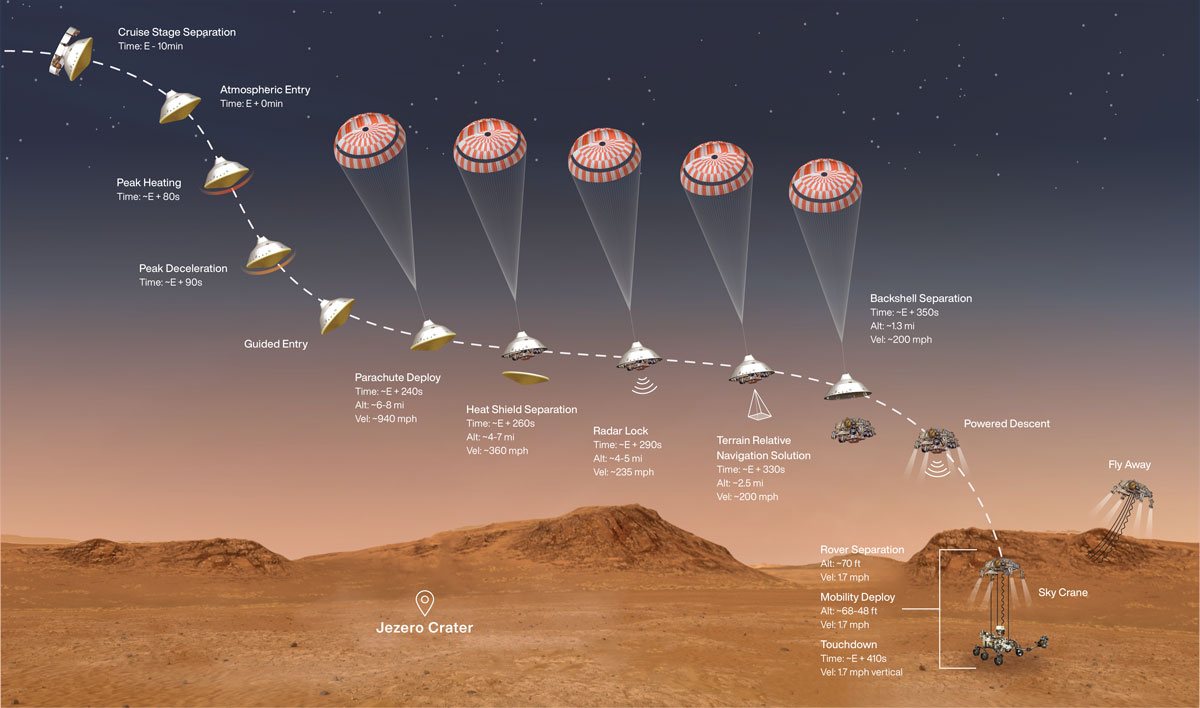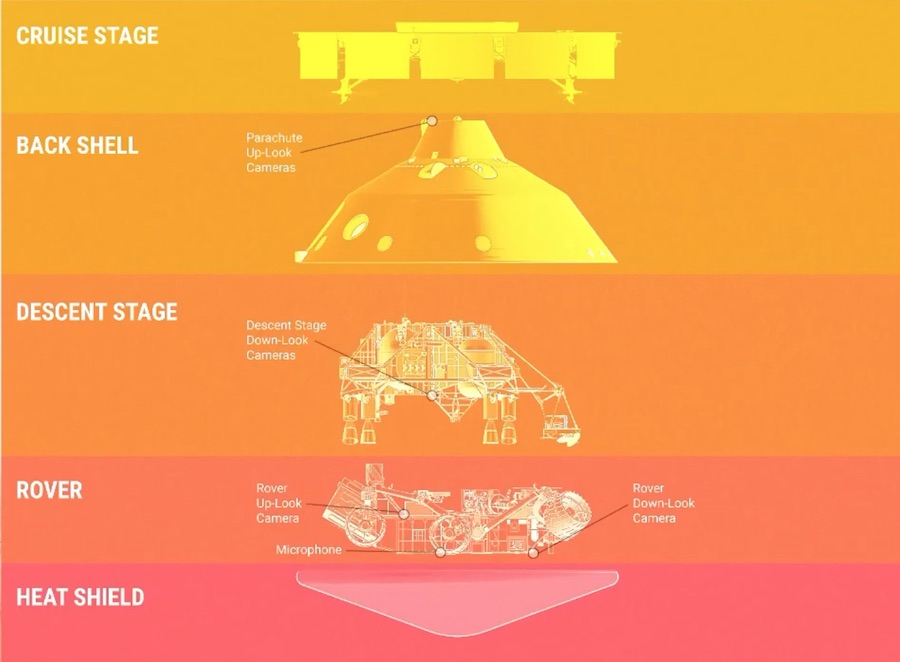
NASA’s nuclear-powered Perseverance rover is set to arrive at Mars on Thursday with a make-or-break entry, descent, and landing. The rover will execute the arrival autonomously, while engineers and scientists back on Earth will have a nail-biting 11-minute wait for signals to reach home confirming the fate of the $2.7 billion mission.
The one-ton rover is on the final stretch of a seven-month journey from Earth to Mars, seeking to become the ninth U.S. spacecraft that has successfully landed on the Red Planet.
The mission is aiming to land inside a 4-mile-wide (7-kilometer) zone inside Jezero Crater, an impact basin scientists believe was flooded with liquid water billions of years ago.
Perseverance was ferried to Mars by a cruise stage, which carried solar panels and thrusters for course correction maneuvers on the 293 million-mile (471 million-kilometer) interplanetary journey. One of the first tasks for Perseverance before it can land on Mars is to jettison the ring-shaped cruise stage.
Ground teams at NASA’s Jet Propulsion Laboratory in Pasadena, California, expect to receive confirmation of the cruise stage jettison at 3:38 p.m. EST (2038 GMT), although the actual event will occur 11 minutes earlier. The cruise stage will burn up during entry into the Martian atmosphere, leaving the Perseverance rover — cocooned inside a 14.8-foot-diameter (4.5-meter) thermal shield — to plunge toward the Red Planet’s surface on its own.
NASA expects to receive signals from Perseverance confirming it has entered the Red Planet’s carbon dioxide atmosphere at 3:48 p.m. EST (2048 GMT), kicking off a fast-paced series of events culminating in the lowering of the mobile robot geologist to the Martian surface on its six titanium-supported aluminum wheels. Pressure sensors, temperature probes, and cameras will record data during Perseverance’s entry, descent, and landing.
Engineers at on Earth, some 127 million miles (204 million kilometers) from Mars, expect signals confirming Perseverance’s landing at 3:55 p.m. EST (2055 GMT), assuming everything goes according to plan.
Here’s a step-by-step timeline of the entry, descent, and landing sequence, beginning at the moment Perseverance’s heat shield first encounters the upper traces of the Martian atmosphere:
- Entry+00:00: Atmospheric entry.
- Entry+01:20: Peak entry heating, with temperatures outside the heat shield reaching about 2,370 degrees Fahrenheit (1,300 degrees Celsius).
- Entry+01:30: Peak deceleration.
- Entry+04:00: Perseverance deploys its 70.5-foot-wide (21.5-meter) supersonic parachute at an altitude of about 7 miles (11 kilometers) and a speed of about 940 mph (1,512 kilometers per hour). The craft deploys the chute when it detects that it has reached a predetermined distance from the landing site.
- Entry+04:20: Perseverance jettisons its no-longer-needed heat shield, revealing a landing radar and cameras to help the spacecraft navigate to a safe landing site.
- Entry+04:50: Radar lock on the Martian surface.
- Entry+05:30: Perseverance obtains a terrain relative navigation solution by using images captured by on-board cameras to search for a safe landing site.
- Entry+05:50: The Perseverance rover jettisons its backshell at an altitude of 1.3 miles (2.1 kilometers), freeing the craft’s descent stage to fire eight throttleable retrorockets to slow for landing. After reaching an altitude of about 66 feet, or 20 meters, the descent stage will lower the rover on Nylon cords to a distance of about 25 feet (7.6 meters). The rover’s wheels will deploy before setting down in Jezero Crater.
- Entry+6:50: Perseverance lands on Mars. Pyrotechnics will fire blades to sever the Nylon cords connecting the rover to its descent stage, which will propel itself a safe distance away before impacting the Martian surface.

Engineers and scientists at JPL will listen for signals from Perseverance throughout the entry, descent, and landing. The rover is programmed to beam back status tones via a direct-to-Earth antenna at each milestone.
“We can use those tones to tell us different things like the heat shield has come off, or something like that,” said Allen Chen, the Perseverance rover’s entry, descent, and landing lead at JPL. “Unfortunately, once we get down to backshell separation, Earth will set below the horizon for Perseverance, so the tones will end.”
NASA’s Mars Reconnaissance Orbiter will be flying over Jezero Crater when Perseverance lands. The long-lived orbiter, about to mark 15 years at Mars, will relay a trickle of data from Perseverance back to Earth in near-real time
“That gives us about about eight kilobits per second of data,” Chen said. That’s kind of like half the speed of old school dial-up if you, if you remember that. But that will allow us to see a lot of different things, like what the vehicle is doing … We’ll be able to see what mode we’re in, where we think Perseverance is looking, how fast we’re going, and how high we are above the ground, even the estimate of how much fuel we have left as well.”
NASA’s MAVEN orbiter will also be in range of Perseverance during landing, but MAVEN won’t send the data it records until several hours later.
But none of the telemetry streams are required for Perseverance to land on Mars. “Perseverance will try to land herself, no matter what, even if we don’t get any of that data,” Chen said.
If all goes according to plan, Perseverance could send home its first “thumbnail” images from its hazard cameras moments after landing through the MRO radio relay, revealing the view of Jezero Crater for the first time.
“Once we do get down safely on the surface, we’re all on the edge of our seats to get those first images from Mars,” said Jennifer Trosper, the rover’s deputy project manager at JPL.
NASA’s Odyssey orbiter will fly over Perseverance’s landing site about three-and-a-half hours after touchdown. Odyssey will relay data on the status of the rover, but it’s unlikely ground controllers will get fresh images during Odyssey’s pass, according to Trosper.
At around 9:30 p.m. EST Thursday (0230 GMT Friday), the European ExoMars Trace Gas Orbiter will fly over Jezero Crater. The European orbiter will be positioned to relay a significantly higher volume of data from the rover.
“Hopefully, we’ll be getting some initial images,” Trosper said. “Those would be the front and rear hazcams with the lens covers deployed, because the rover will have to deployed them by then.”
The ExoMars orbiter could provide low-resolution previews of imagery taken by Perseverance’s landing cameras during descent, Trosper said.
Trosper said the Perseverance rover will unfurl its high-gain communications antenna and release camera lens covers shortly after landing, before going to sleep to recharge batteries for additional activations in the coming days and weeks.
One important task will be to determine the orientation and slope of the rover on Mars. That information will help ground teams tell Perseverance where to point its high-bandwidth communications antenna to connect with NASA’s Deep Space Network on Earth.
Perseverance will also raise its remote sensing mast, fitted with a panoramic zoom-capable camera, science instrumentation, and a Martian weather station. Then ground crews will command Perseverance to take its first short test drive, setting the stage for a mission planned to last at least two years looking for signs of ancient Martian life, and collecting rock samples for return to Earth by future spacecraft.
Perseverance will also release NASA’s Ingenuity helicopter some time in the next few months. The JPL-built rotorcraft will be the first such vehicle to fly through the atmosphere of another planet, and teams plan several low-altitude, short-duration test flights before Perseverance continues on with its primary mission.
Email the author.
Follow Stephen Clark on Twitter: @StephenClark1.



